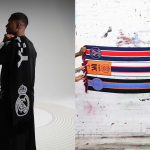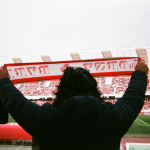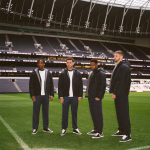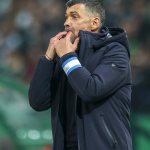
Nobody can do without football scarves anymore
The strange trajectory of the football scarf, from curves to high fashion and then into any lookbook
April 23rd, 2022
Once upon a time there were scarves, hundreds of thousands of fans, one on top of the other stretching their club scarves as far as possible to create a wall of colours and logos that gave the impression of falling onto the pitch. In the stadium they were a practical item, to defend themselves from the great cold and wind, and a choreographic one, to wave their support for their favourite team. In fashion, they have become a must-have for any shoot, the necessary accessory to elevate the capsule collection in question to the rank of fashion. In the explosion of collaborations between sports clubs and brands in both sportswear and high fashion, no one can resist including one.
Now any occasion is a good one to make a scarf, be it for a charity occasion, to seal a particular collection or simply to get a message across with a nice, direct text in caps lock. More fun and sophisticated than a t-shirt, less expensive and demanding than a sweatshirt, it is the perfect accessory to pair with any outfit. It's a statement, it immediately frames the category of the wearer like a football team scarf should. You're one of us or you're one of the others.
A trend that started in 2017 thanks to Gosha and Demna's Footballs Scarves, and then took over the rest of the fashion world. In fact, within a short space of time, Off-White, with a scarf featuring the famous arrows, and Burberry, inspired by the tradition of English clubs, followed the trend. An unstoppable success that in just a few years has gone through the various stages of the path that any object takes as it normalises, moving from the catwalks to everyday life. Except that in this case it has been taken a full circle, starting from the stands and then returning, but charged with a new status and vitality.
From Y-3's for Real Madrid to Andrew Saville's for Manchester United, not to mention the series of scarves made by Paris Saint-Germain who, keeping faith with their brand, released a short sequence of them in collaboration with .3Paradis, Fly Nowhere and one inside the collection for Lionel Messi's ninth Ballon d'Or win. And then the one for Venezia in the Rain Pack to protect against the rain at Pier Luigi Penzo, the one for AS Roma's Lunar Pack on the occasion of the Chinese New Year, the one for the collaboration between the Danish national team and BLS Hafnia together with Hummel, the one for Inter "I M Winner" for the Scudetto victory and many more.
Football scarves are no longer surprising, and it would be more surprising if they were to be absent from a collection. They are the item that closes every list in brand press releases and the first slide in the photogallery, and also the accessory that tops sales. They have made the rounds, they have left the stadiums and returned, enjoying the new status acquired on the journey. They are the validation of a process that has normalised the football aesthetic in everyday life, imposing in the process an identity and community character that both sport and fashion seek to intercept nowadays.
















